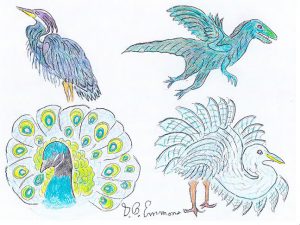The most surprising discovery about birds by paleontologists uncovering prehistoric fossils is that dinosaurs likely grew feathers between their bones to stay warm during the Jurassic period.
This proved that birds were descended from prehistoric monsters like Tyrannosaurus Rex. From this, we also learned that the origin of bird feathers is a historical adventure in research.
The fact that they learned to fly some 150 million years ago and did not perish when volcanic ash smothered most other life makes birds the most successful surviving creatures on the planet.
Perhaps the oldest bird watching expression “Birds of a feather flock together” goes back in time some 400 years to 1599 when The Lexicons of Early Modern Englishwas compiled. And in nature, birds do, in fact, form flocks as safety in numbers helps prevent predation.
Today, feathers are classified in groups of anatomy: body down (for warmth), contour (overall smooth appearance), and flight (wings and tail). The color and design of plumage, like the peacocks of my illustration, enables, in particular, males to become better at flirting with potential partners. Courtship displays are plumage spectaculars with macho males pouting and inflating in an exotic ego trip.
Feathers also permit seasonal molting and color morphing such as with the snowy owl and Northern ptarmigan changing to white in winter and brown in summer. The popular partridge audibly uses his wing feathers to drum on a log for female attention. At each longitude, the tone of his plumage matches the degree of grey or red of the clay in the soil of its habitat.
However, in the 19th century, the beauty of wild bird feathers suddenly and fatefully turned against them with the fashion feather market for ladies millinery centers in New York and London. More than 5 million birds annually were being slaughtered, including 130,000 egrets for their brilliant white gossamer wisps.
But two Boston socialite ladies, Harriet Hemenway and Minna Hall, who campaigned for women to join a publicity intervention movement, turned the environmental tide and eventually 900 signed up to form a national federation. Through their efforts, the Migratory Bird Treaty Act of 1918 made it illegal to take migratory birds for their feathers, putting an end to the omnipresent harmful plumage market and replaced it with the National Audubon Society, American Bird Conservation, and Partners In Flight.
Since Leonardo da Vinci failed to invent a human flying machine by substituting feathers with artificial material, the artistic aerial ascent of angels and archangels filled a human need for the spiritual mythology he failed to achieve. I hope you nevertheless share with me the aerial wonder of nature and the ethereal flight connecting a celestial bridge between Heaven and Earth.
By George B. Emmons
